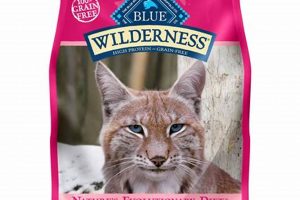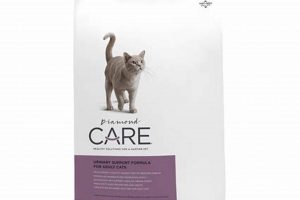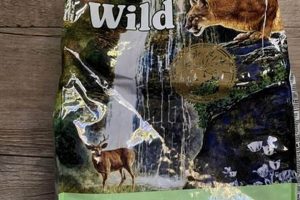A common ingredient in many commercial cat food formulations, this processed plant fiber is derived from wood pulp or other plant sources. It serves as a source of insoluble fiber, contributing to the overall dietary fiber content of the food. For example, a dry cat food might list it among its ingredients to increase bulk and aid in digestion.
The incorporation of this component offers several advantages. It can help manage weight by providing a feeling of fullness without adding significant calories. Additionally, it can aid in regulating bowel movements and reducing hairball formation. Historically, the use of fiber in pet food has evolved from a simple filler to a recognized component with specific health benefits.
The following sections will delve deeper into the specific applications, potential considerations, and regulatory aspects related to its use in feline diets. Understanding these facets is crucial for both manufacturers and consumers seeking to provide optimal nutrition for their cats.
Considerations Regarding Fiber Supplementation in Feline Diets
The following provides guidance related to the inclusion of a specific processed plant fiber within feline diets. The responsible implementation of this ingredient can yield positive results, but awareness of potential implications is paramount.
Tip 1: Determine Necessity: Evaluate the cat’s individual needs. Increased fiber intake may be beneficial for weight management, hairball control, or digestive regularity. However, not all cats require supplemental fiber. A consultation with a veterinarian can clarify the need.
Tip 2: Monitor Stool Consistency: Observe the cat’s stool after introducing a food containing this ingredient. Changes in stool consistency, such as diarrhea or constipation, may indicate that the fiber level is not optimal for the individual cat.
Tip 3: Gradual Introduction is Key: Abrupt dietary changes can cause gastrointestinal upset. Gradually introduce any new food containing this fiber, blending it with the existing food over a period of several days to allow the cat’s digestive system to adjust.
Tip 4: Hydration is Crucial: Fiber absorbs water. Ensure the cat has access to fresh, clean water at all times, particularly when consuming a diet with increased fiber content. Dehydration can exacerbate constipation.
Tip 5: Consider Underlying Health Conditions: Certain medical conditions, such as inflammatory bowel disease, may necessitate careful consideration of fiber intake. Veterinary guidance is essential in such cases.
Tip 6: Check Ingredient Label Thoroughly: Be aware that the ingredient may be listed under various names. Familiarize yourself with common synonyms to accurately assess the fiber content of the food.
Tip 7: Balance with Other Nutrients: A diet should be balanced. Excessive fiber can interfere with the absorption of other essential nutrients. Ensure the food provides a complete and balanced nutritional profile.
Appropriate and monitored fiber inclusion offers potential benefits; however, careful observation and veterinary guidance remain essential for optimal feline health.
The subsequent section will address the regulatory landscape surrounding the use of this ingredient in commercial cat food formulations.
1. Fiber source
As a fiber source, this specific type of plant-derived fiber functions primarily to augment the indigestible content within feline diets. Its inclusion affects the gastrointestinal tract by adding bulk, which stimulates peristalsis and aids in the passage of waste. This action can be particularly beneficial for cats prone to constipation or irregular bowel movements. Commercial cat food manufacturers incorporate the ingredient to mimic the fiber content that felines would naturally consume in the form of fur and other indigestible matter from prey animals. The availability of this processed fiber offers a consistent and controlled method for achieving the desired fiber levels.
The relationship between the fiber source and its inclusion in cat food extends beyond simple bulk provision. The specific physical and chemical characteristics of this fiber source, such as particle size and water-holding capacity, influence its functionality. For example, a coarsely ground version may be more effective at promoting fecal bulking, while a finer version might be better at binding water and preventing diarrhea. Understanding these nuances allows for targeted application in specific formulations. Furthermore, the inclusion of this fiber source can affect the overall palatability and texture of the cat food. Careful consideration is required to ensure that the addition does not negatively impact the cat’s willingness to consume the product.
In conclusion, the ingredient’s role as a fiber source provides a functional and controlled method for augmenting the fiber content of feline diets. While offering distinct advantages related to digestive health, its implementation must consider particle size, water-holding capacity, and potential impacts on palatability. The ultimate goal remains to provide a balanced and palatable diet that supports optimal feline health and well-being, leveraging the advantages of this particular fiber source without compromising nutritional completeness.
2. Calorie reduction
The inclusion of processed plant fiber in feline diets is often strategically employed to facilitate calorie reduction without compromising satiety. This approach is particularly relevant in weight management programs for cats susceptible to obesity or those requiring a lower energy intake.
- Volume Enhancement
Processed plant fiber contributes significant bulk to the food without adding substantial calories. This added volume helps to create a feeling of fullness, reducing the cat’s urge to overeat. For instance, a cat food designed for weight loss might contain a higher percentage of this ingredient compared to a standard formula. The impact is a lower calorie density per unit of food consumed.
- Reduced Digestibility
Unlike digestible carbohydrates and fats, this plant fiber is largely indigestible. This property directly influences the overall calorie content of the food, as the cat’s body cannot break down and absorb energy from this component. Weight management formulas leverage this characteristic to lower the total metabolizable energy of the diet.
- Metabolic Impact
While not directly metabolized for energy, this fiber may influence metabolic processes indirectly. It can modulate the rate of glucose absorption, potentially mitigating blood sugar spikes that can contribute to fat storage. However, the precise mechanisms and extent of these metabolic effects require further investigation.
- Portion Control Support
By increasing the feeling of fullness, the inclusion of this fiber aids in effective portion control. Owners can provide what appears to be a substantial meal while simultaneously reducing the overall calorie intake. This can be especially helpful in multi-cat households where portion management is critical to prevent weight gain in certain individuals.
The integration of processed plant fiber as a strategy for calorie reduction in feline diets offers a multifaceted approach to weight management. By increasing volume, reducing digestibility, potentially influencing metabolic processes, and supporting portion control, this ingredient contributes to the development of effective weight loss and maintenance programs. However, optimal utilization requires careful formulation to ensure adequate nutrient provision and prevent any adverse effects on digestive health.
3. Digestive regularity
Digestive regularity in felines, characterized by consistent and predictable bowel movements, is crucial for overall health and well-being. The inclusion of processed plant fiber in cat food formulations directly influences this regularity, acting as a key modulator of gastrointestinal function.
- Fecal Bulking and Transit Time
Processed plant fiber increases fecal bulk. This bulk stimulates peristaltic contractions within the intestines, facilitating the movement of waste material through the digestive tract. The result is a reduced transit time, minimizing the duration that waste remains in the colon, thus reducing the risk of constipation. For example, a cat experiencing infrequent bowel movements may benefit from a diet containing an appropriate amount of this fiber to promote more regular elimination.
- Water Retention and Stool Consistency
The water-holding capacity of this fiber affects stool consistency. By absorbing water within the digestive tract, it helps prevent both excessively hard and excessively loose stools. This balance is critical for maintaining digestive health and preventing discomfort. An example is a cat with a tendency toward diarrhea, where the inclusion of this fiber can help to absorb excess water and produce firmer stools.
- Gut Microbiome Modulation
While not extensively fermented in the feline gut, processed plant fiber can influence the composition and activity of the gut microbiome. It provides a substrate for certain bacterial populations, indirectly affecting the production of short-chain fatty acids and other metabolites that contribute to intestinal health. This modulation can support a balanced microbial environment, further promoting digestive regularity.
- Prevention of Constipation and Obstipation
By increasing fecal bulk, promoting peristalsis, and influencing stool consistency, processed plant fiber plays a significant role in preventing constipation and obstipation in cats. Regular bowel movements are essential to prevent the buildup of waste material and the associated discomfort and potential health complications. This is especially important in older cats, which may be more prone to digestive issues.
The multifaceted influence of processed plant fiber on fecal bulking, water retention, gut microbiome, and prevention of constipation underscores its importance in maintaining digestive regularity in felines. By strategically incorporating this ingredient into cat food formulations, manufacturers can contribute to the overall digestive health and well-being of cats, ensuring consistent and comfortable bowel movements. The fiber component supports and facilitates healthy stool features.
4. Hairball control
The relationship between hairball control and the inclusion of processed plant fiber in feline diets is significant. Cats, through their grooming habits, ingest considerable amounts of hair. This ingested hair can accumulate in the gastrointestinal tract, forming hairballs. If not effectively eliminated, these hairballs can cause discomfort, vomiting, and, in severe cases, intestinal blockages. The inclusion of this processed fiber serves as a critical component in mitigating these issues.
Processed plant fiber aids in hairball control through several mechanisms. Primarily, it increases the bulk of the intestinal contents. This increased bulk helps to encapsulate the ingested hair, facilitating its passage through the digestive tract and subsequent excretion in the feces. The fiber’s abrasive texture aids in scraping the stomach and intestinal walls. Secondly, the fiber stimulates intestinal motility, further promoting the movement of hair through the system, thus preventing accumulation. For example, cats on diets with insufficient fiber often experience more frequent and severe hairball regurgitation compared to those consuming fiber-enriched foods. Manufacturers will often include hairball control formulas with a raised inclusion rate of the fiber.
In summary, the strategic incorporation of processed plant fiber into feline diets is essential for effective hairball control. It contributes to hair encapsulation, enhances intestinal motility, and facilitates the safe passage of ingested hair. Understanding this connection is crucial for pet owners and manufacturers alike, ensuring that cats receive adequate dietary support to minimize hairball-related complications and maintain digestive health. This understanding highlights the important consideration of preventative measures for pet owners.
5. Nutrient absorption
The relationship between nutrient absorption and the presence of processed plant fiber in cat food is complex and warrants careful consideration. While this ingredient serves beneficial functions such as promoting digestive regularity and aiding in hairball control, its impact on the bioavailability of essential nutrients demands scrutiny. Excessive fiber inclusion can, theoretically, interfere with the absorption of certain vitamins, minerals, and other vital compounds. This occurs due to several potential mechanisms, including increased intestinal transit speed, which reduces the time available for nutrient uptake, and physical binding of nutrients by the fiber matrix, rendering them inaccessible for absorption. A real-life example would involve a cat consuming a high-fiber diet exhibiting deficiencies in fat-soluble vitamins despite adequate vitamin levels in the food itself. This illustrates the practical significance of understanding that while fiber is beneficial, the correct balance with other nutrients must be considered.
Manufacturers mitigate these potential negative effects through careful formulation practices. These include adjusting the levels of vitamins and minerals to compensate for any reduced bioavailability caused by the fiber. Additionally, the selection of specific types of plant fiber, with varying water-holding and binding capacities, allows for fine-tuning of the overall impact on nutrient absorption. For instance, finely ground fiber might have a different effect compared to coarser varieties. The practical application of this knowledge involves conducting rigorous feeding trials to assess the actual nutrient bioavailability in the final product. This empirical data then guides the optimization of nutrient levels to ensure that cats receive the full nutritional benefit from their food.
In conclusion, while this type of plant fiber offers advantages in feline diets, its potential to influence nutrient absorption necessitates a balanced approach. Careful formulation, selection of appropriate fiber types, and thorough evaluation of nutrient bioavailability are essential. The goal is to leverage the benefits of fiber without compromising the cat’s ability to absorb and utilize essential nutrients, ultimately supporting optimal health and well-being. Challenges remain in accurately predicting the precise effects of fiber on nutrient absorption, highlighting the need for ongoing research in this area, including the impact of powdered cellulose on cat food.
6. Stool consistency
Stool consistency serves as a crucial indicator of digestive health in felines, directly influenced by dietary components such as processed plant fiber in cat food. The appropriate inclusion and management of this fiber type can optimize fecal characteristics, reflecting a balanced and functional digestive system. Deviation from normal stool consistency, either towards excessive hardness or looseness, signals potential dietary imbalances or underlying health concerns.
- Water Retention Capacity
Processed plant fiber possesses the capacity to absorb and retain water within the digestive tract. This directly influences stool hydration, preventing excessive drying that leads to constipation. Conversely, the fiber’s water-binding properties can also mitigate diarrhea by solidifying excessively loose stools. The type of fiber and its degree of processing affect its water retention abilities. For example, a finely ground fiber may exhibit greater water-holding capacity compared to a coarsely ground variety, influencing the resulting stool consistency.
- Influence on Intestinal Transit Time
This fiber type increases the bulk of fecal matter, thereby stimulating peristaltic contractions within the intestines. This action accelerates the transit time of waste through the digestive tract, preventing prolonged water absorption from the stool. A shortened transit time helps maintain stool moisture and prevents excessive hardening. Cats consuming diets deficient in fiber may experience prolonged transit times and resultant constipation, highlighting the importance of adequate fiber levels for maintaining optimal stool consistency.
- Impact on Fecal Bulk and Form
The addition of processed plant fiber increases the overall volume of fecal matter. This bulking effect contributes to the formation of well-defined, solid stools. Sufficient bulk also aids in complete evacuation of the bowels, preventing the retention of fecal material that can lead to discomfort and digestive issues. In cases where stool is consistently small and poorly formed, increasing the fiber content of the diet can often improve fecal bulk and form.
- Modulation of Gut Microbiota
Although cats are primarily carnivores, processed plant fiber can influence the composition and activity of the gut microbiota. Specific bacterial populations may utilize this fiber as a substrate, producing short-chain fatty acids that contribute to intestinal health and function. A balanced gut microbiome supports optimal digestion and contributes to the maintenance of normal stool consistency. Dysbiosis, or an imbalance in the gut microbiota, can lead to digestive disturbances and altered stool characteristics.
These facets highlight the integrated role of fiber in regulating stool consistency. A well-formulated cat food, containing an appropriate type and amount of processed plant fiber, is essential for maintaining digestive health and ensuring consistent, well-formed stools. Monitoring stool characteristics provides valuable insights into the cat’s digestive health and the suitability of its diet. Deviations from normal stool consistency warrant veterinary consultation and dietary adjustments.
Frequently Asked Questions
The following addresses common inquiries regarding the inclusion of processed plant fiber in feline diets, providing informative answers based on current scientific understanding.
Question 1: Is processed plant fiber simply a filler ingredient with no nutritional value?
No. While it contributes minimal calories, it provides essential fiber, promoting digestive health and aiding in hairball control. It is a functional ingredient, not merely an inert substance.
Question 2: Can this type of fiber cause digestive upset in cats?
While generally well-tolerated, abrupt dietary changes involving increased fiber content can lead to temporary gastrointestinal distress. Gradual introduction and appropriate fiber levels are essential to minimize any adverse effects.
Question 3: Does processed plant fiber interfere with the absorption of other nutrients?
Excessive fiber levels could potentially reduce nutrient bioavailability. However, reputable manufacturers carefully formulate cat foods to compensate for any such effects, ensuring complete and balanced nutrition.
Question 4: Is this ingredient safe for cats with sensitive stomachs or pre-existing digestive conditions?
Cats with sensitive stomachs or digestive disorders require individual assessment. Veterinary consultation is essential to determine the appropriateness of fiber-enriched diets and to monitor for any adverse reactions.
Question 5: What is the source of this processed plant fiber, and is it sustainable?
It is typically derived from wood pulp or other plant materials. Sustainability practices vary among manufacturers; inquiring about sourcing practices can provide insights into environmental responsibility.
Question 6: How much processed plant fiber is considered safe and beneficial in cat food?
Optimal levels vary depending on individual cat needs and the specific formulation of the food. Guidelines from veterinary nutritionists and reputable pet food manufacturers provide reliable benchmarks for safe and effective inclusion.
In summary, processed plant fiber serves as a valuable component in feline diets when used judiciously. Understanding its benefits and potential considerations enables informed decisions regarding cat food selection.
Further research into the long-term effects and optimal utilization of processed plant fiber in feline nutrition remains ongoing. The final sections provide resources for further education and informed consumer choices.
Powdered Cellulose in Cat Food
The preceding exploration has illuminated the multifaceted role of this specific fiber in feline diets. It functions not merely as an inert filler but as a functional component influencing digestive regularity, hairball management, and calorie control. Its impact on nutrient absorption necessitates careful formulation and vigilant monitoring. The optimal inclusion level depends on individual feline needs and requires informed decision-making.
Future advancements in feline nutrition will likely refine our understanding of the complex interaction between this fiber and the feline digestive system. Continuous evaluation of its sourcing, processing, and long-term health implications remains essential. Responsible pet ownership demands informed choices, underscoring the importance of consulting with veterinary professionals and critically evaluating product information.







